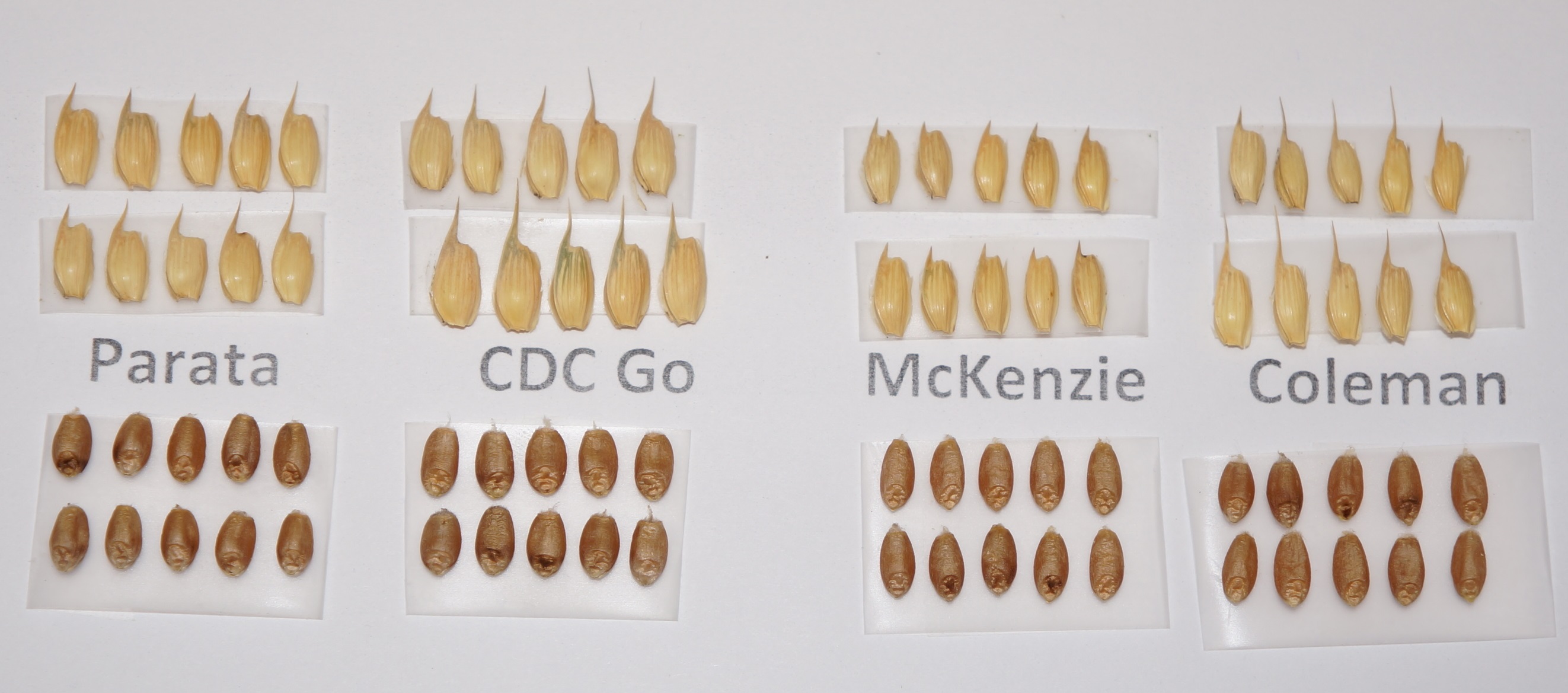Parata
| Denomination: | 'Parata' |
|---|---|
| Botanical Name: | Triticum aestivum |
| Applicant/Holder: |
The Governors of the University of Alberta Suite 4000 TEC Centre, 10230 Jasper Avenue Edmonton, Alberta T5J 4P6 Canada |
| Breeder: |
Dean Spaner, University of Alberta, Edmonton, Alberta |
| Application Date: | 2017-05-11 |
| Provisional Protection:: | 2017-05-11 |
| Application Number: | 17-9220 |
| Grant of Rights Date: | 2019-04-01 |
| Certificate Number: | 5955 |
| Grant of Rights Termination Date: | 2039-04-01 |
Variety Description
Varieties used for comparison: 'CDC Go', 'McKenzie' and 'Coleman'
Summary: At booting, the flag leaf of 'Parata' is longer than that of 'McKenzie'. At maturity, the plants of 'Parata' are taller than those of 'CDC Go'. The spikes of 'Parata' are longer than those of 'McKenzie'. In cross-section, the straw pith of 'Parata' is thin whereas it is medium to thick in 'Coleman' and thick in 'McKenzie'. The shoulder shape of the lower glume of 'Parata' is straight whereas it is strongly sloping to slightly sloping for 'Coleman', slightly sloping for 'CDC Go' and it is elevated for 'McKenzie'. The lower glume beak is of medium length in 'Parata' whereas it is short in 'McKenzie'. The brush hairs on the kernel of 'Parata' are short whereas they are of medium length on 'McKenzie' and 'Coleman'.
Description:
PLANT: common hard red spring type, erect to semi-erect growth habit at the 5 to 9 tiller stage, matures early to mid-season
SEEDLING: strong intensity of anthocyanin colouration of coleoptile, glabrous lower leaf sheaths and blades
FLAG LEAF: absent or very weak anthocyanin colouration of auricles, absent or very weak glaucosity of sheath, glabrous blade and sheath
CULM NECK: absent to weak glaucosity, straight
STRAW: thin pith in cross-section, no anthocyanin colouration at maturity
SPIKE: weak to medium glaucosity at heading, parallel sided shape in profile, medium density, white at maturity, erect attitude
AWNS: present, shorter than length of spike, white at maturity
LOWER GLUME: medium length and width, glabrous
LOWER GLUME SHOULDER: medium to broad, straight
LOWER GLUME BEAK: medium length, slightly curved
LOWEST LEMMA: straight to slightly curved beak
KERNEL: medium red colour, small to medium size, short to medium length and width, oval shape, rounded cheek shape, short brush hairs, narrow to medium width of crease, medium depth of crease
GERM: small to medium size, oval shape
Origin & Breeding History: 'Parata' (experimental designations UAW0601*F6MBK013 and PT772) originated from the cross 'AC Splendor'/'AC Domain'//'CDC Go' made in the winter of 2006-2007 at the University of Alberta in Edmonton, Alberta. The F2 generation was grown in the field at the Edmonton Research Station in 2007 whereas, the F3 generation was grown in a winter nursery near Lincoln, New Zealand in the winter of 2007 and 2008. In 2008, the F4 generation grown in plots at the Edmonton Research Station was selected on the basis of plant type, maturity, lodging and disease resistance. Twenty nine chosen F5 heads were grown as head rows near Lincoln, New Zealand during the winter of 2008-2009 where 'Parata' was selected based on plant type, early maturity, straw strength and reaction to yellow and leaf rust. Seed of the bulked F6 head-row was grown as a single entry in an unreplicated yield trial in Edmonton in 2009, as a hill plot in leaf and stem rust, bunt and leaf spot nurseries in Edmonton, and as a hill plot in a stripe rust nursery near Creston, British Colombia. Based on cumulative agronomic and quality data, one of the lines was evaluated as UAW0601*F6MBK013 in replicated yield trials at one Saskatchewan and five Alberta locations in 2010. In 2011, UAW0601*F6MBK013 was evaluated in the Parkland B test as entry 10 and; subsequently, evaluated in the Parkland Wheat Cooperative tests from 2012 to 2014 as PT772.
Tests & Trials: The comparative trials for 'Parata' conducted during 2015 and 2017 in Edmonton, Alberta were planted in a RCB design and consisted of 3 replicates for each variety. Each 4.5 metres squared plots consisted of 6 rows 4.5 metres in length with a row spacing of 0.19 metres. The planting density was 300 plants per square metre. Measured characteristics were based on 30 measurements per plant or parts of plants per variety. Mean differences were significant at the 5% probability level based on LSD values.
Comparison tables for 'Parata' with reference varieties 'CDC Go', 'McKenzie' and 'Coleman'
Flag leaf length (cm)
| 'Parata' | 'CDC Go' | 'McKenzie' | 'Coleman' | |
|---|---|---|---|---|
| mean (2015) (LSD=2.5) | 18.4 | 18.2 | 15.8 | 16.3 |
| std. deviation (2015) | 2.1 | 2.5 | 1.9 | 1.9 |
| mean (2017) (LSD=1.9) | 20.3 | 23.3 | 14.6 | 19.3 |
| std. deviation (2017) | 3.2 | 3.0 | 2.7 | 2.7 |
Plant height at maturity (including awns) (cm)
| 'Parata' | 'CDC Go' | 'McKenzie' | 'Coleman' | |
|---|---|---|---|---|
| mean (2015) (LSD=5.2) | 83.8 | 73.9 | 85.3 | 86.9 |
| std. deviation (2015) | 3.1 | 3.6 | 3.8 | 4.1 |
| mean (2017) (LSD=3.4) | 86.1 | 76.9 | 86.9 | 93.0 |
| std. deviation (2017) | 2.8 | 3.9 | 4.1 | 5.2 |
Spike length (excluding awns) (cm)
| 'Parata' | 'CDC Go' | 'McKenzie' | 'Coleman' | |
|---|---|---|---|---|
| mean (2015) (LSD=0.67) | 8.4 | 8.8 | 7.3 | 8.3 |
| std. deviation (2016) | 0.68 | 0.75 | 0.73 | 0.65 |
| mean (2017) (LSD=0.56) | 8.2 | 8.5 | 7.8 | 8.5 |
| std. deviation (2017) | 0.55 | 0.83 | 0.94 | 0.76 |
Click on image for larger view

Wheat: 'Parata' (left) with reference varieties 'CDC Go' (centre left), 'McKenzie' (centre right) and 'Coleman' (right)
Click on image for larger view

Wheat: 'Parata' (left) with reference varieties 'CDC Go' (centre left), 'McKenzie' (centre right) and 'Coleman' (right)
- Date modified: